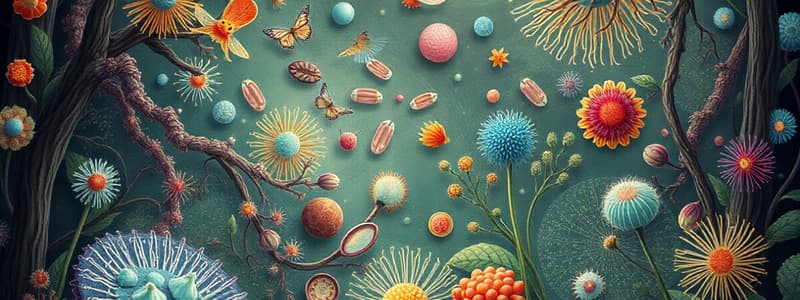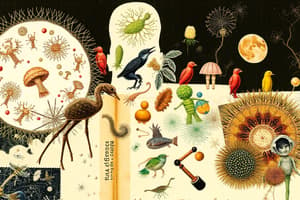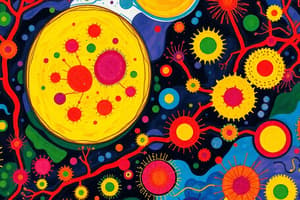Podcast
Questions and Answers
Which of the following groups is NOT considered a type of microorganism?
Which of the following groups is NOT considered a type of microorganism?
- Protozoa
- Multicellular algae (correct)
- Bacteria
- Viruses
What is a primary role of microorganisms in the environment?
What is a primary role of microorganisms in the environment?
- Photosynthesis
- Producing oxygen
- Causing diseases
- Breaking down organic matter (correct)
Which of the following is true regarding microorganisms?
Which of the following is true regarding microorganisms?
- They all contribute negatively to human life.
- They only include bacteria and viruses.
- They are visible only with a microscope. (correct)
- They can be seen with the naked eye.
Which of the following microorganisms primarily contribute to the recycling of chemicals such as nitrogen and sulfur?
Which of the following microorganisms primarily contribute to the recycling of chemicals such as nitrogen and sulfur?
Which characteristic is common to all microorganisms?
Which characteristic is common to all microorganisms?
Flashcards
What are microorganisms?
What are microorganisms?
Microorganisms are living organisms that are too small to be seen with the naked eye and require a microscope for observation.
List some examples of microorganisms.
List some examples of microorganisms.
Bacteria, cyanobacteria, rickettsiae, chlamydiae, fungi, unicellular algae, protozoa, and viruses are all considered microorganisms.
How do microorganisms contribute to the environment?
How do microorganisms contribute to the environment?
Microorganisms play a crucial role in maintaining the balance of chemical elements in the environment. They decompose dead organisms and recycle essential elements like carbon, nitrogen, and phosphorus.
What is Microbiology?
What is Microbiology?
Signup and view all the flashcards
Why are microorganisms important to humans?
Why are microorganisms important to humans?
Signup and view all the flashcards
Study Notes
Microbial Diversity
- Microorganisms include bacteria, cyanobacteria, rickettsiae, chlamydiae, fungi, single-celled algae, protozoa, and viruses.
- All are microscopic organisms.
Microorganism Contributions
- Most microorganisms support human life by maintaining ecological balance.
- They break down dead matter, and recycle essential elements like carbon, nitrogen, sulfur, phosphorus.
Studying That Suits You
Use AI to generate personalized quizzes and flashcards to suit your learning preferences.
Description
Explore the fascinating world of microorganisms including bacteria, fungi, and viruses. Discover how these microscopic beings play a crucial role in maintaining ecological balance and supporting human life by recycling essential elements.




